The Clevo P870DM2 / Mythlogic Phobos 8716 Laptop Review: DTR With GTX 1080
by Brett Howse on October 27, 2016 2:00 PM ESTGPU Performance
This is really the section that is the most interesting. This is our first look at Pascal in a notebook, and it really can’t be understated just what a big transition this is on the notebook side. Maxwell was a fantastic launch by NVIDIA, but it was the final play on the 28 nm process they had been using for so long. With the launch of Pascal, they finally get to exploit a new 16 nm TSMC process to improve performance and efficiency across the board.
| NVIDIA High-End Mobile GPU Specification Comparison | ||||||
| GTX 1080 | GTX 980 | GTX 980M | GTX 880M | |||
| CUDA Cores | 2560 | 2048 | 1536 | 1536 | ||
| Texture Units | 160 | 128 | 96 | 96 | ||
| ROPs | 64 | 64 | 64 | 32 | ||
| Core Clock | 1556MHz | 1064MHz | 1038MHz | 954MHz | ||
| Boost Clock | 1733MHz | Undefined | Undefined | Undefined | ||
| Memory Clock | 10Gbps GDDR5X | 7Gbps GDDR5 | 5Gbps GDDR5 | 5Gbps GDDR5 | ||
| Memory Bus Width | 256-bit | 256-bit | 256-bit | 256-bit | ||
| VRAM | 8GB | 4GB/8GB | 4GB | 4GB | ||
| FP64 | 1/32 | 1/32 | 1/32 | 1/24 | ||
| GPU | GP104 | GM204 | GM204 | GK104 | ||
| Transistor Count | 7.2B | 5.2B | 5.2B | 3.5B | ||
| Manufacturing Process | TSMC 16nm | TSMC 28nm | TSMC 28nm | TSMC 28nm | ||
| Launch Date | 08/16/2016 | 09/22/2015 | 10/07/2014 | 03/12/2014 | ||
The change was so significant that NVIDIA has completely rebranded the notebook parts with the same branding as the desktop parts, and it’s not just an illusion. The GTX 1080, which is the card outfitted in the review unit, features the same 2560 CUDA cores as the desktop part, the same 8 GB of 10 Gbps GDDR5X, and the same ROPs as the desktop card. The only difference is a small drop in the core clock rate to keep the TDP in check, but it does keep the same 1733 MHz boost clock. Compare this to the outgoing GTX 980M which was pretty dominant in its time, which had just 1536 CUDA cores with a 1038 MHz core clock. Even the short lived GTX 980 for notebooks had only 2048 CUDA cores at 1064 MHz. GTX 1080 in a notebook is a serious jump in capabilities. Thanks to Mythlogic for sending us one right after launch so we could check it out.
We’ve run the laptop through our gaming tests, with a couple of new ones added as well. To compare the Clevo P870DM2 to any other notebook we’ve tested, check out the notebook bench.
3DMark
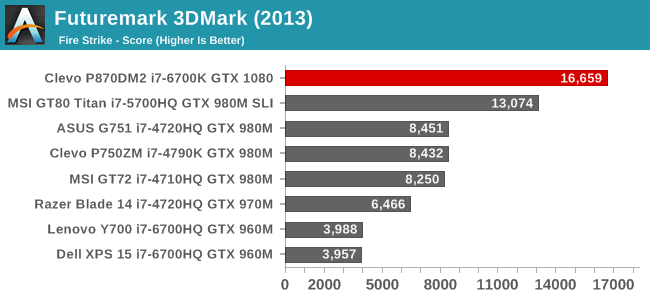

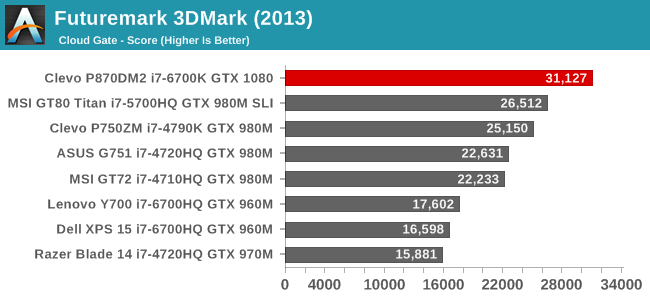
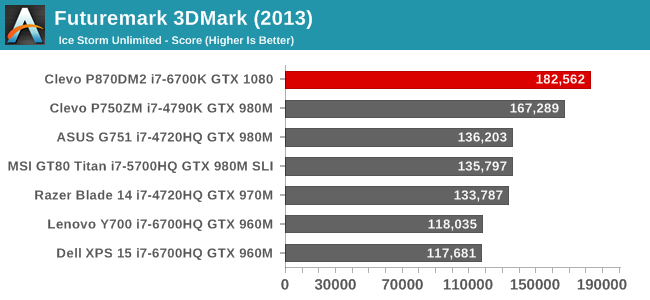

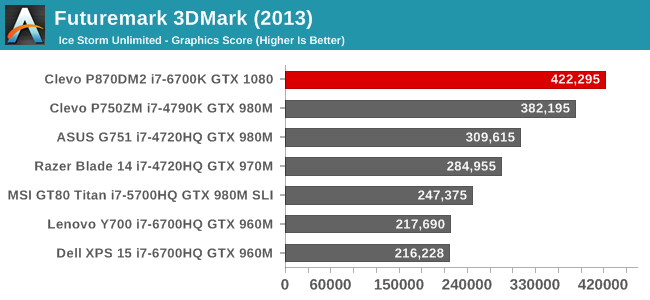
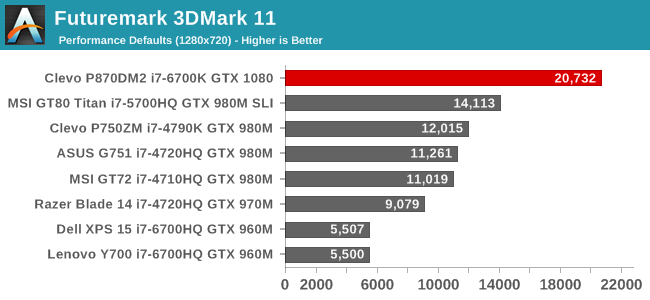
First up is a couple of synthetic tests. Futuremark’s 3DMark is a long-standing graphics test, and makes for an easy comparison across devices. Here it is already apparent just how much of a jump in performance the NVIDIA GTX 1080 is compared to the GTX 980M in the outgoing models. Even the SLI GTX 980M in the MSI GT80 Titan has no chance against a single GTX 1080.
GFXBench

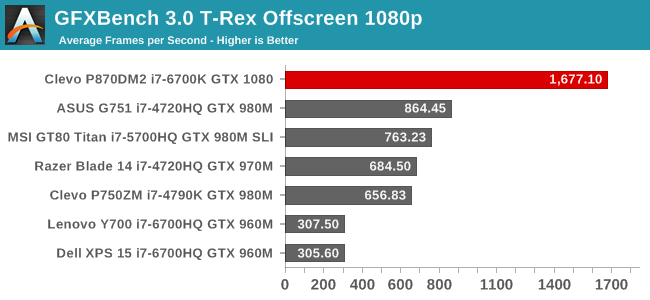
Once there are a couple more data points, we’ll have to move to the newer versions of GFXBench, but this mobile focused test is really not a stress at all on any desktop GPU. Still it’s fun to see just how far these can go, and the GTX 1080 sets a ridiculous score of 1677 frames per second in T-Rex.
Bioshock Infinite
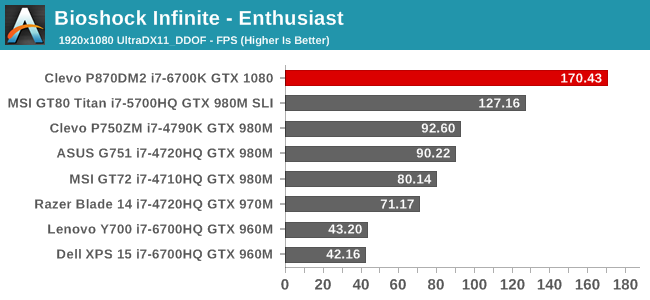
This game is getting a bit long in the tooth, but it has still been a decent notebook benchmark when turned up to Ultra settings. There is also a great amount of data going back many years, which is helpful too. Once again, the GTX 1080 demolishes this test with 170 frames per second on our enthusiast settings.
Dragon Age Inquisition

This epic RPG from Bioware is one of my favorite games ever, and at maximum settings it can really punish graphics cards too. At 115 fps, this is the first game to come close to the 120 Hz of the display, but still the gulf between the GTX 980M and the GTX 1080 is gigantic.
GRID Autosport
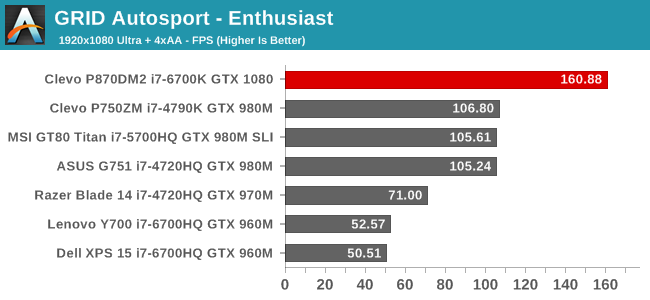
Once again, the giant leap in performance is on display here. GRID is more CPU bound than some other games, at least on the same GPU architecture, but Core i7-6700K with GTX 1080 has no issues.
Shadow of Mordor

Once again, Shadow of Mordor has been a good test for notebooks, with previous generation devices barely getting an average of 60 FPS on Ultra settings, but the GTX 1080 has no such problems, with the new laptop having a framerate 242% of the GTX 980M in the Clevo P750ZM. The SLI GT80 Titan is a bit closer, but still isn’t in the same league.
Tomb Raider
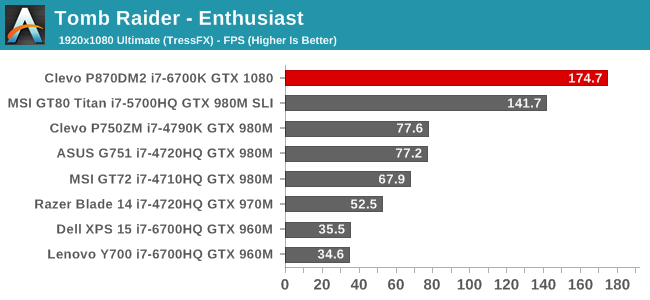
The original Tomb Raider is such a great game that it would be difficult to see it go, but now with Rise of the Tomb Raider available, once there are some more data points for the new version, the old one will have to be relegated to the history books. This was one of the games that SLI helped a lot on, and you can see that the SLI GTX 980M in the GT80 Titan pulls pretty close to the GTX 1080, but compared to a single GTX 980M in the P750ZM, the GTX 1080 is 225% faster.
Rise of the Tomb Raider


Despite this being a new DX12 game, you can see that the GTX 1080 really has no issues running it at 1920x1080. The Very High settings need a lot of vRAM, and the 4 GB vRAM in the ASUS G751 GTX 980M couldn’t even complete the benchmark on Enthusiast settings, so just to give a generational showing the Mainstream settings of 1600x900 High are also shown.
Dota 2

If you’re a big fan of eSports, or just a fan of online arena battle games, Dota 2 might be the game you play. If so, fret not. The GTX 1080 does pretty well on this game.
Civilization VI

Only just released, Civilization VI is the latest game in the Civilization series. Civ has generally been pretty intense on the CPU, and it appears that is the case again with Civilization VI. No other systems have been tested (yet) but just for some sort of comparison, my desktop with the same CPU, but a GTX 760, would only get about 25 FPS on the Enthusiast settings. 80 FPS is by far the lowest score on any of the gaming tests, but at the same time the game engine is pretty CPU limited. The difference between 1366x768 Medium and 1920x1080 Ultra is not very significant, which is a good indication that the game is limited in a non-GPU way.
GPU Conclusion
Comparing the GTX 1080 to any previous GTX M branded card is going to show, once again, just what a jump the move to 16 nm Pascal is. The GTX 1080 is easily twice as fast, or more, than the GTX 980M. There seems to be a good reason NVIDIA decided to drop the mobile branding, because the gap between notebook and desktop is as small as ever.










61 Comments
View All Comments
Morawka - Thursday, October 27, 2016 - link
i dont think nvidia is done with pascal mobile parts. I'm sure they will release some midrange stuff here soon.Meaker10 - Friday, October 28, 2016 - link
The vapor chamber cooler on the SLI 1080 config can keep both cards at 1910mhz core clocks during gaming with both cards loaded with the right mounting :)The_Assimilator - Friday, October 28, 2016 - link
Given that Pascal is probably the last gasp of the Maxwell architecture, I think it was a simple matter of nVIDIA wanting to push it as far as it could go. (That, and wanting to crush AMD Polaris.) So slightly higher TDP was probably not a concern of theirs, especially given how much more performance you're getting for that power.As for your desire for potentially slower cards that draw even less power, I'm actually with you on that one. I'm tired of seeing "low-end" cards that require dual-slot cooling and additional power connectors. Bloody hell, back in the day, the 8800 GT was near the top of the hill in terms of performance and it was a single-slotter with 1 PCIe power connector.
BillyONeal - Thursday, October 27, 2016 - link
I'm happy they stopped with the mobile GPU mess. I was sick of looking at laptops and having no idea how they'd perform because the nomenclature of the desktop and mobile parts were different, and nobody did reviews or had good benchmarks of the mobile parts.Sure, due to thermal constraints the mobile implementations are going to perform a little bit worse than desktop equivalents in some circumstances, but not ~50% worse as was common just a few years ago.
Spunjji - Friday, October 28, 2016 - link
We have a new problem, though - actual performance is extremely dependent on cooling implementation due to the huge delta in boost clocks these things can produce.It's great from the perspective of getting the most possible out of your own device, but from a view of trying to buy a notebook it's a bit nightmarish.
BillyONeal - Friday, October 28, 2016 - link
Sure, but that was also true with "m" branded GPUs. Crappy cooling will still tank perf.versesuvius - Thursday, October 27, 2016 - link
DTR or overspeced (overspect ?) AIO?Michael Bay - Thursday, October 27, 2016 - link
Top cover. Just why.anactoraaron - Thursday, October 27, 2016 - link
"But Mythlogic also adds their own tools to do a couple of things. Mythlogic has a control center..."Correct me if I'm wrong but that looks like the standard Clevo control center. I have that on my 2 year old Clevo W370ss. I don't have the other software, but from the ui design I would assume that it is Clevo software also. Nothing looks to be exclusive to Mythlogic to me.
anactoraaron - Thursday, October 27, 2016 - link
Also after seeing the performance relative to the 980M, that new surface aio looks even less worth the money. MS didn't need to go full 1080, but a 1070 or even a 1060 would have been a better choice. Don't get me wrong, but with the surface devices it seems to me like they keep missing the mark, and I keep telling myself 'maybe they'll get the next one right and I'll pick one up.' Only to get let down every year.